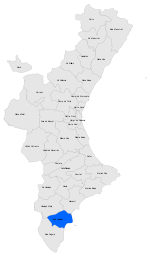Mystery Play of Elche
Bien de Interés Cultural landmarks in the Province of AlicanteChristianity and antisemitismElcheMasterpieces of the Oral and Intangible Heritage of HumanityMedieval drama ... and 7 more
Pages with Spanish IPAPages with Valencian IPAPlays based on the BiblePlays set in the 1st centurySpanish folk musicValencianValencian culture

The Misterio de Elche (Spanish pronunciation: [misˈteɾjo ˈðe ˈeltʃe]), in English the Mystery Play of Elche or Elche Mystery Play and in Catalan Misteri d'Elx (Valencian pronunciation: [misˈtɛɾi ˈðɛʎtʃ]), is a liturgical drama from the Middle Ages that reenacts the Dormition and Assumption of the Blessed Virgin Mary. The two-act mystery play is performed annually on 14 and 15 August in the Basilica de Santa María in the city of Elche. In 2001, UNESCO declared it one of the Masterpieces of the Oral and Intangible Heritage of Humanity and, in 2008, inscribed it on its Representative List.
Excerpt from the Wikipedia article Mystery Play of Elche (License: CC BY-SA 3.0, Authors, Images).Mystery Play of Elche
carrer de la Fira, Elx / Elche la Vila
Geographical coordinates (GPS) Address Nearby Places Show on map
Geographical coordinates (GPS)
| Latitude | Longitude |
|---|---|
| N 38.266944444444 ° | E -0.69833333333333 ° |
Address
carrer de la Fira 6
03201 Elx / Elche, la Vila
Valencian Community, Spain
Open on Google Maps









